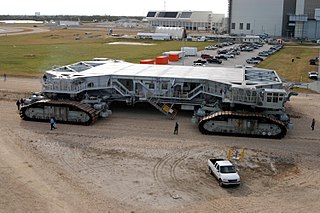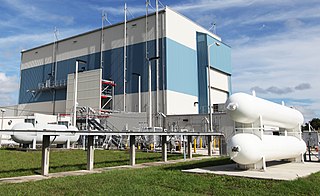
The John F. Kennedy Space Center, located on Merritt Island, Florida, is one of the National Aeronautics and Space Administration's (NASA) ten field centers. Since December 1968, KSC has been NASA's primary launch center of human spaceflight. Launch operations for the Apollo, Skylab and Space Shuttle programs were carried out from Kennedy Space Center Launch Complex 39 and managed by KSC. Located on the east coast of Florida, KSC is adjacent to Cape Canaveral Space Force Station (CCSFS). The management of the two entities work very closely together, share resources and operate facilities on each other's property.

The Vehicle Assembly Building, or VAB, is a large building at NASA's Kennedy Space Center (KSC), designed to assemble large pre-manufactured space vehicle components, such as the massive Saturn V, the Space Shuttle and the Space Launch System, and stack them vertically onto one of three mobile launcher platforms used by NASA. As of March 2022, the first Space Launch System (SLS) rocket was assembled inside in preparation for the Artemis 1 mission, launched on November 16, 2022.

Pamela Ann Melroy is an American retired United States Air Force officer and NASA astronaut serving as the deputy administrator of NASA. She served as pilot on Space Shuttle missions STS-92 and STS-112 and commanded mission STS-120 before leaving the agency in August 2009. After serving as deputy program manager of Space Exploration Initiatives with Lockheed Martin, Melroy joined the Federal Aviation Administration in 2011, where she was a senior technical advisor and director of field operations for the FAA's Office of Commercial Space Transportation.

Margaret Rhea Seddon is an American surgeon and retired NASA astronaut. After being selected as part of the first group of astronauts to include women in 1978, she flew on three Space Shuttle flights: as a mission specialist on STS-51-D and STS-40, and as a payload commander for STS-58, accumulating over 722 hours in space. On these flights, she built repair tools for a US Navy satellite and performed medical experiments.

The Aerojet Rocketdyne RS-25, also known as the Space Shuttle Main Engine (SSME), is a liquid-fuel cryogenic rocket engine that was used on NASA's Space Shuttle and is currently used on the Space Launch System (SLS).

The crawler-transporters, formally known as the Missile Crawler Transporter Facilities, are a pair of tracked vehicles used to transport spacecraft from NASA's Vehicle Assembly Building (VAB) along the Crawlerway to Launch Complex 39. They were originally used to transport the Saturn IB and Saturn V rockets during the Apollo, Skylab and Apollo–Soyuz programs. They were then used to transport Space Shuttles from 1981 to 2011. The crawler-transporters carry vehicles on the mobile launcher platforms used by NASA, and after each launch return to the pad to take the platform back to the VAB.

Stephanie Diana Wilson is an American engineer and a NASA astronaut. She flew to space onboard three Space Shuttle missions, and is the second African American woman to go into space, after Mae Jemison. As of 2022, her 42 days in space are the second most of any female African American astronaut, having been surpassed by Jessica Watkins in 2022.

A mobile launcher platform (MLP), also known as mobile launch platform, is a structure used to support a large multistage space vehicle which is assembled (stacked) vertically in an integration facility and then transported by a crawler-transporter (CT) to a launch pad. This becomes the support structure for launch.

Joan Elizabeth Higginbotham is an electrical engineer and a former NASA astronaut. She flew aboard Space Shuttle Discovery mission STS-116 as a mission specialist and is the third African American woman to go into space, after Mae Jemison and Stephanie Wilson.

The Rocco A. Petrone Launch Control Center is a four-story building at NASA's Kennedy Space Center on Merritt Island, Florida, used to manage launches of launch vehicles from Kennedy Space Center Launch Complex 39. Attached to the southeast corner of the Vehicle Assembly Building, the LCC contains offices; telemetry, tracking, and instrumentation equipment; and firing rooms.

STS-133 was the 133rd mission in NASA's Space Shuttle program; during the mission, Space Shuttle Discovery docked with the International Space Station. It was Discovery's 39th and final mission. The mission launched on February 24, 2011, and landed on March 9, 2011. The crew consisted of six American astronauts, all of whom had been on prior spaceflights, headed by Commander Steven Lindsey. The crew joined the long-duration six person crew of Expedition 26, who were already aboard the space station. About a month before lift-off, one of the original crew members, Tim Kopra, was injured in a bicycle accident. He was replaced by Stephen Bowen.

Karen LuJean Nyberg is an American mechanical engineer and retired NASA astronaut. Nyberg became the 50th woman in space on her first mission in 2008.

Nicole Marie Passonno Stott is an American engineer and a retired NASA astronaut. She served as a flight engineer on ISS Expedition 20 and Expedition 21 and was a mission specialist on STS-128 and STS-133. After 27 years of working at NASA, the space agency announced her retirement effective June 1, 2015. She is married to Christopher Stott, a Manx-born American space entrepreneur.

Launch Complex 39B (LC-39B) is the second of Launch Complex 39's three launch pads, located at NASA's Kennedy Space Center in Merritt Island, Florida. The pad, along with Launch Complex 39A, was first designed for the Saturn V launch vehicle, which at the time was the United States' most powerful rocket. Typically used to launch NASA's crewed spaceflight missions since the late 1960s, the pad is currently configured for use by the agency's Space Launch System rocket, a Shuttle-derived launch vehicle which is currently used in the Artemis program and subsequent Moon to Mars campaigns. The pad had also been leased by NASA to aerospace company Northrop Grumman, for use as a launch site for their Shuttle-derived OmegA launch vehicle, for National Security Space Launch flights and commercial launches, before the OmegA program was cancelled.

The retirement of NASA's Space Shuttle fleet took place from March to July 2011. Discovery was the first of the three active Space Shuttles to be retired, completing its final mission on March 9, 2011; Endeavour did so on June 1. The final shuttle mission was completed with the landing of Atlantis on July 21, 2011, closing the 30-year Space Shuttle program.

The Space Launch System (SLS) is an American super heavy-lift expendable launch vehicle used by NASA. As the primary launch vehicle of the Artemis Moon landing program, SLS is designed to launch the crewed Orion spacecraft on a trans-lunar trajectory. The first SLS launch was the uncrewed Artemis 1, which took place on 16 November 2022.

Artemis 1, officially Artemis I and formerly Exploration Mission-1 (EM-1), was an uncrewed Moon-orbiting mission. As the first major spaceflight of NASA's Artemis program, Artemis 1 marked the agency's return to lunar exploration after the conclusion of the Apollo program five decades earlier. It was the first integrated flight test of the Orion spacecraft and Space Launch System (SLS) rocket, and its main objective was to test the Orion spacecraft, especially its heat shield, in preparation for subsequent Artemis missions. These missions seek to reestablish a human presence on the Moon and demonstrate technologies and business approaches needed for future scientific studies, including exploration of Mars.

NASA's Exploration Ground Systems (EGS) Program is one of three programs based at NASA's Kennedy Space Center in Florida. EGS was established to develop and operate the systems and facilities necessary to process and launch rockets and spacecraft during assembly, transport and launch. EGS is preparing the infrastructure to support NASA's Space Launch System (SLS) rocket and its payloads, such as the Orion spacecraft for Artemis I. Artemis I is the first to launch in a series of increasingly complex missions that will enable human exploration to the Moon and Mars.

The Multi-Payload Processing Facility (MPPF) is a facility at Kennedy Space Center constructed by NASA in either 1994 or 1995 and used for spacecraft and payload processing. Prior to being assigned the role of processing the Orion spacecraft, the MPPF was used to process solely non-hazardous payloads.





















